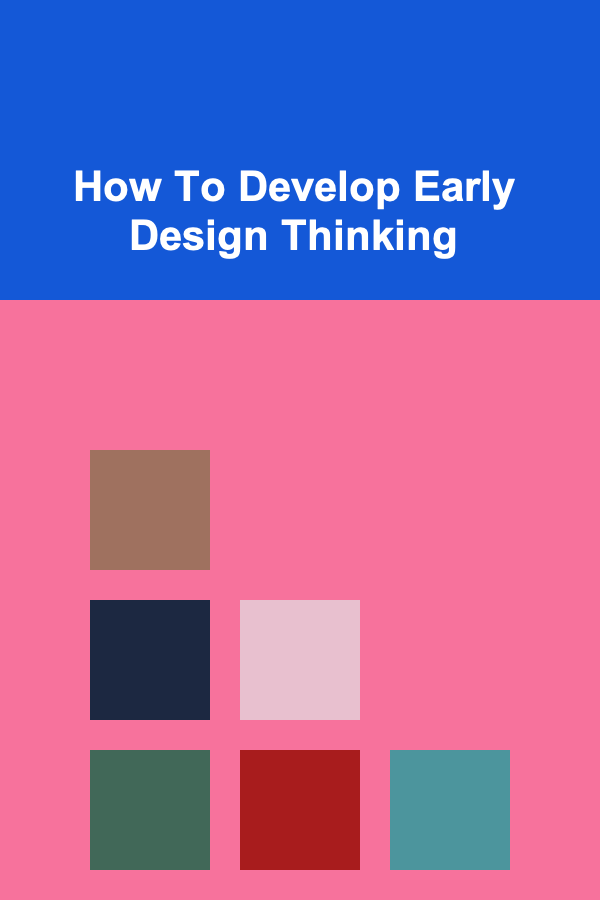
How To Develop Early Design Thinking
ebook include PDF & Audio bundle (Micro Guide)
$12.99$9.99
Limited Time Offer! Order within the next:

Design thinking is a powerful methodology that has become a cornerstone of innovation, problem-solving, and creative processes across various industries. The concept, which emphasizes empathy, collaboration, and iterative development, is increasingly being applied in fields ranging from product design and engineering to education and healthcare. However, one of the most critical and often overlooked aspects of design thinking is the early stage, where the foundation for successful problem-solving is laid. Developing early design thinking is key to ensuring that projects are not only innovative but also user-centered and effective. This article will delve deep into the various stages of developing early design thinking, the tools and techniques that can be used, and how to cultivate this mindset for long-term success.
Understanding Early Design Thinking
Before diving into how to develop early design thinking, it's essential to understand what it entails. Design thinking, at its core, is a human-centered approach to innovation. It involves understanding the user's needs, defining the problem, ideating potential solutions, prototyping, and testing. The "early" phase of design thinking focuses on the first few stages: empathy , defining the problem , and ideation. These stages are critical because they lay the groundwork for the rest of the process. A strong start in the early stages ensures that the solutions created will truly address user needs and create meaningful impacts.
1. Empathy: Understanding the User's World
Empathy is the first and arguably the most crucial step in design thinking. In the early stages, designers must step into the shoes of the user and understand their experiences, pain points, and needs. Developing empathy goes beyond just gathering user feedback; it requires designers to immerse themselves in the user's world, experiencing things from their perspective.
To build empathy, there are several strategies designers can use:
- User Interviews: Conduct one-on-one interviews with real users to understand their problems, desires, and expectations. Ask open-ended questions to encourage them to share their feelings and experiences. It's important to create a comfortable environment where the user feels open to sharing honest insights.
- Observation: Spend time observing users in their natural environment. Whether it's watching someone use a product or observing how they interact with a service, paying attention to non-verbal cues and behaviors can reveal valuable insights that users may not articulate directly.
- Immersive Experiences: In some cases, designers may need to put themselves in the user's shoes through immersion. For example, a designer working on healthcare solutions might spend time shadowing medical professionals or patients to fully understand their challenges.
- Personas and Journey Mapping: Create user personas based on the data collected during the empathy phase. These personas should represent different types of users and their goals. Additionally, journey mapping can help visualize the user's experience over time, allowing designers to identify pain points and moments of delight.
2. Defining the Problem: Framing the Challenge
Once the designer has gathered insights from users, the next step is to define the problem clearly. In early design thinking, this step is crucial because it ensures that the team is working towards solving the right issue. A poorly defined problem can lead to misguided solutions that miss the mark or fail to address the underlying user needs.
To effectively define the problem, designers should:
- Analyze Insights: Review the data collected during the empathy phase and look for patterns, common themes, and key user needs. Organize these insights in a way that helps clarify what the core problem is.
- Problem Statements: Create a clear and concise problem statement that reflects the needs of the user. A well-crafted problem statement should address the "who" (the user), the "what" (the need or problem), and the "why" (the importance or impact of solving it). For example, "We need to help busy professionals manage their time better because they often feel overwhelmed and stressed."
- Challenge Assumptions: In the early stages, it's important to challenge assumptions about what the problem might be. Designers should not only focus on the symptoms of the problem but also question the root cause. By challenging assumptions, designers can uncover deeper insights that lead to more innovative solutions.
3. Ideation: Generating Creative Solutions
Once the problem has been clearly defined, it's time to move on to the ideation phase. Ideation is where creativity and brainstorming come into play. This phase allows designers to generate a wide variety of ideas and potential solutions before narrowing them down to the best options.
Some useful strategies for ideation include:
- Brainstorming Sessions: Gather a diverse team of people and engage in free-flowing brainstorming sessions. Encourage participants to share as many ideas as possible without judgment. In the early stages, it's important to generate quantity over quality.
- Mind Mapping: Use mind maps to visually organize ideas and explore different branches of solutions. This technique can help designers see the connections between different concepts and develop more creative ideas.
- SCAMPER: SCAMPER is an acronym that stands for Substitute, Combine, Adapt, Modify, Put to Another Use, Eliminate, and Reverse. By asking these questions about an existing product or idea, designers can stimulate new ways of thinking and come up with innovative solutions.
- Sketching: Quickly sketching out ideas on paper or a whiteboard can help visualize potential solutions. Sometimes, putting ideas into a visual form helps identify problems or opportunities that weren't immediately apparent.
- Crazy Eights: A technique often used in design sprints, Crazy Eights involves rapidly sketching eight different ideas in eight minutes. This forces designers to think quickly and creatively, without overthinking the process.
Tools for Cultivating Early Design Thinking
While empathy, problem definition, and ideation are the core aspects of early design thinking, there are several tools and methods that can enhance these stages and help designers develop their thinking more effectively.
1. Design Sprints
Design sprints are time-boxed, intensive periods of design thinking that allow teams to rapidly prototype and test ideas in a short amount of time (typically five days). The sprint methodology follows a clear sequence of stages: understanding, sketching, deciding, prototyping, and testing. It's a great way to foster early design thinking by forcing teams to focus and iterate quickly.
2. Brainstorming Tools
Several digital tools help facilitate brainstorming and ideation, especially for remote teams. Tools like Miro , MURAL , and Lucidchart offer virtual whiteboards and templates to structure brainstorming sessions. These tools allow teams to collaborate in real time, capture ideas, and organize them for future reference.
3. User Testing Platforms
To validate ideas early on, platforms like Lookback , UserTesting , and Optimal Workshop allow designers to test prototypes and gather feedback from real users. Even during the ideation phase, it's important to test rough concepts and see how users respond before investing too much time or resources into a single idea.
4. Personas and Journey Mapping Tools
Tools like Xtensio and Smaply help designers create and visualize personas and user journeys. These tools can enhance the empathy phase by providing templates and frameworks for capturing user insights and visualizing the user's experience.
Cultivating the Design Thinking Mindset Early
Developing early design thinking is not just about applying specific tools or following a set of steps. It's also about cultivating the right mindset within yourself and your team. This mindset involves being open to learning, embracing failure as a step toward innovation, and maintaining a user-centric approach throughout the process.
Here are a few tips for developing the design thinking mindset:
- Foster Curiosity: Constantly ask questions and be curious about how things work and why users behave the way they do. Curiosity is the foundation of empathy and innovation.
- Encourage Collaboration: Design thinking thrives in collaborative environments. Bring together people from diverse backgrounds, perspectives, and skills. Collaboration encourages creativity and leads to more well-rounded solutions.
- Embrace Iteration: In the early stages, perfection is not the goal. Focus on creating rough ideas and prototypes, and be prepared to iterate and refine them based on feedback. Iteration allows for continuous improvement and helps you find the best solution.
- Fail Early, Fail Forward: In design thinking, failure is seen as a valuable learning opportunity. Don't be afraid to fail early in the process, as this helps you identify what doesn't work before committing significant resources.
Conclusion
Developing early design thinking is essential for creating innovative, user-centered solutions. By focusing on empathy, problem definition, and ideation, and using the right tools and techniques, designers can ensure that their solutions are grounded in real user needs and are more likely to succeed. Cultivating the design thinking mindset in the early stages of a project sets the foundation for creativity, collaboration, and long-term success. Embrace the process, iterate quickly, and always keep the user at the center of your thinking. By doing so, you'll be well on your way to creating impactful solutions that make a difference.

How to Create a Family Photo Challenge for Lasting Memories
Read More
How to Secure Your Garage and Shed from Break-Ins
Read More
How To Understand the Theory of Relativity (Astronomy Context)
Read More
How to Understand Liquidity in Markets
Read More
How to Prepare Your Garden for Autumn
Read More
How to Grasp the Development of New Antibiotics
Read MoreOther Products

How to Create a Family Photo Challenge for Lasting Memories
Read More
How to Secure Your Garage and Shed from Break-Ins
Read More
How To Understand the Theory of Relativity (Astronomy Context)
Read More
How to Understand Liquidity in Markets
Read More
How to Prepare Your Garden for Autumn
Read More